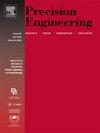微透镜阵列金刚石车削的位置相关系统动力学建模
IF 3.7
2区 工程技术
Q2 ENGINEERING, MANUFACTURING
Precision Engineering-Journal of the International Societies for Precision Engineering and Nanotechnology
Pub Date : 2025-05-22
DOI:10.1016/j.precisioneng.2025.05.017
引用次数: 0
摘要
在先进光学应用中对微透镜阵列(MLAs)的需求日益增长,需要能够实现亚微米形状精度和纳米表面质量的超精密加工技术。介绍了一种基于位置依赖的mla超精密金刚石车削系统动力学建模方法。建立了无芯永磁直线电机(CPMLM)驱动慢速刀具伺服(STS)系统的机电模型,以表征电磁场变化引起的位置相关非线性。该模型建立了一个位置相关的传递函数,可以准确地预测不同加工位置的动态跟踪误差。实验验证证实了模型和实际系统响应之间的强烈一致性,在0-200 Hz带宽范围内,频域偏差低于0.3 dB。利用这种预测能力,引入了一种结合分段轨迹优化的迭代补偿策略来系统地减少跟踪误差。对比加工实验表明,该方法的跟踪误差降低了63.6%,表面形状精度提高了56.1%,有效地缓解了位置相关的加工不一致。这些发现为提高超精密加工系统的精度和稳定性提供了一个强大的框架,为高性能光学元件制造提供了实际的进步。本文章由计算机程序翻译,如有差异,请以英文原文为准。
Position-dependent system dynamics modeling for diamond turning of microlens arrays
The increasing demand for micro-lens arrays (MLAs) in advanced optical applications necessitates ultra-precision machining techniques capable of achieving sub-micron form accuracy and nanometric surface quality. This study introduces a novel position-dependent system dynamics modeling approach for ultra-precision diamond turning of MLAs. A electromechanical model of the coreless permanent magnet linear motor (CPMLM) driving the slow tool servo (STS) system is developed to characterize position-dependent nonlinearities arising from electromagnetic field variations. The proposed model establishes a position-dependent transfer function that accurately predicts dynamic tracking errors across different machining positions. Experimental validation confirms strong agreement between the modeled and actual system responses, with frequency-domain deviations below 0.3 dB across the 0–200 Hz bandwidth. Leveraging this predictive capability, an iterative compensation strategy incorporating segmented trajectory optimization is introduced to systematically reduce tracking errors. Comparative machining experiments demonstrate that the proposed method achieves a 63.6 % reduction in tracking errors and a 56.1 % improvement in MLA surface form accuracy, effectively mitigating position-dependent machining inconsistencies. These findings provide a robust framework for enhancing the precision and stability of ultra-precision machining systems, offering practical advancements for high-performance optical component fabrication.
求助全文
通过发布文献求助,成功后即可免费获取论文全文。
去求助
来源期刊
CiteScore
7.40
自引率
5.60%
发文量
177
审稿时长
46 days
期刊介绍:
Precision Engineering - Journal of the International Societies for Precision Engineering and Nanotechnology is devoted to the multidisciplinary study and practice of high accuracy engineering, metrology, and manufacturing. The journal takes an integrated approach to all subjects related to research, design, manufacture, performance validation, and application of high precision machines, instruments, and components, including fundamental and applied research and development in manufacturing processes, fabrication technology, and advanced measurement science. The scope includes precision-engineered systems and supporting metrology over the full range of length scales, from atom-based nanotechnology and advanced lithographic technology to large-scale systems, including optical and radio telescopes and macrometrology.

 求助内容:
求助内容: 应助结果提醒方式:
应助结果提醒方式:


